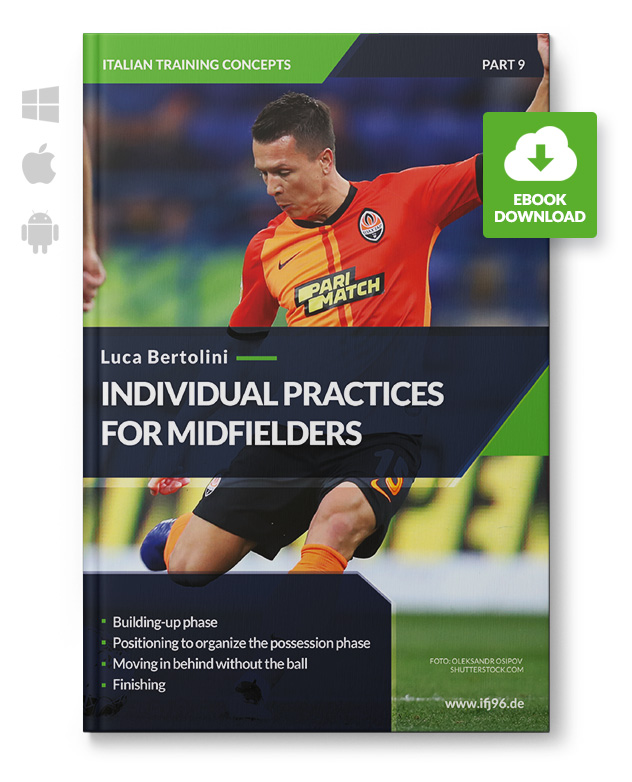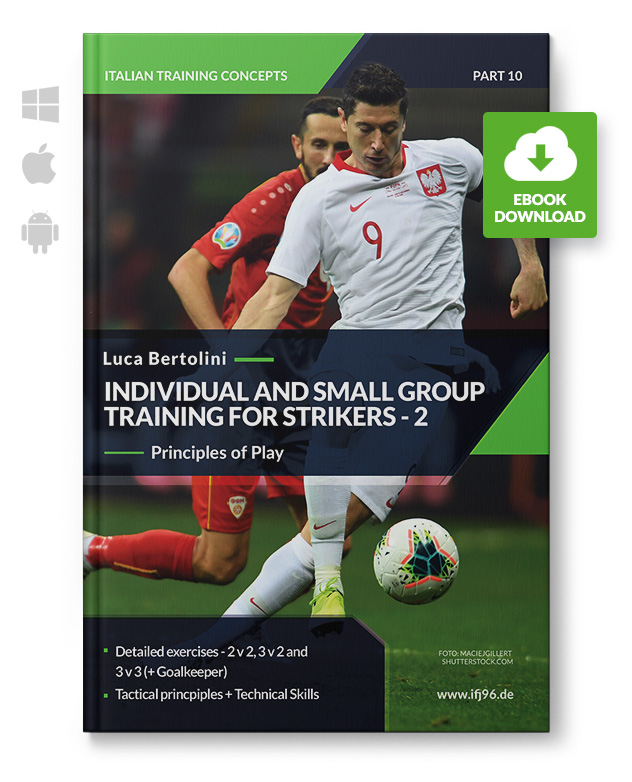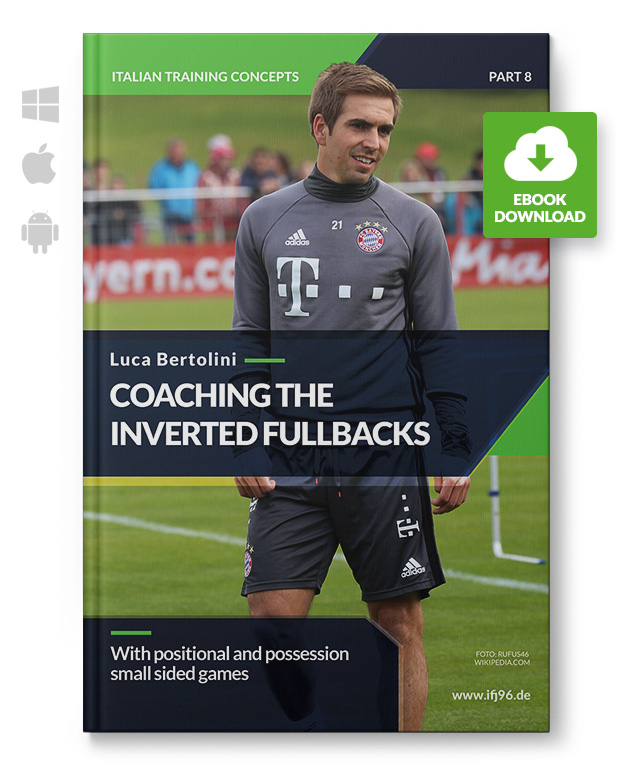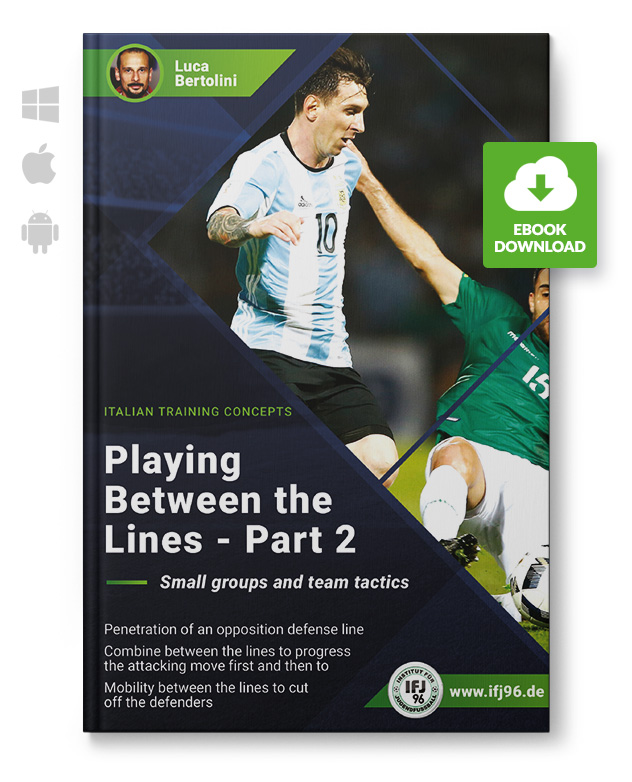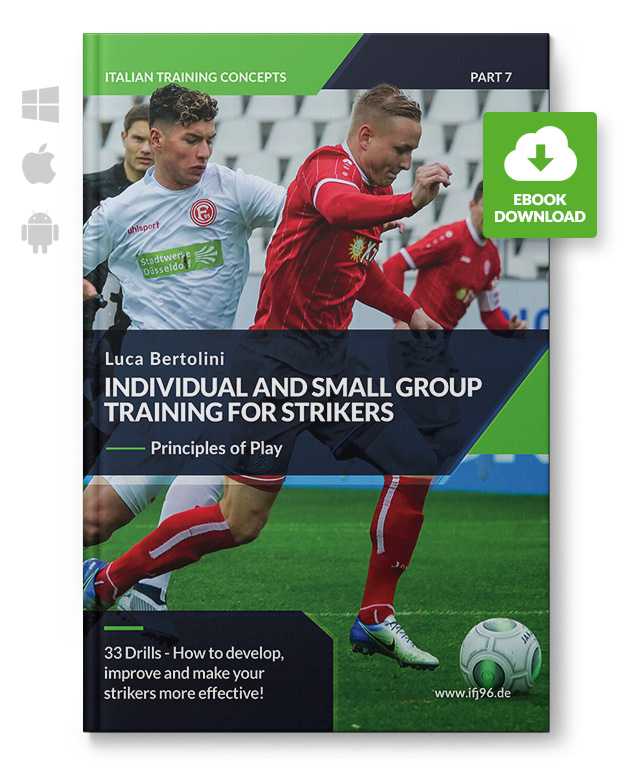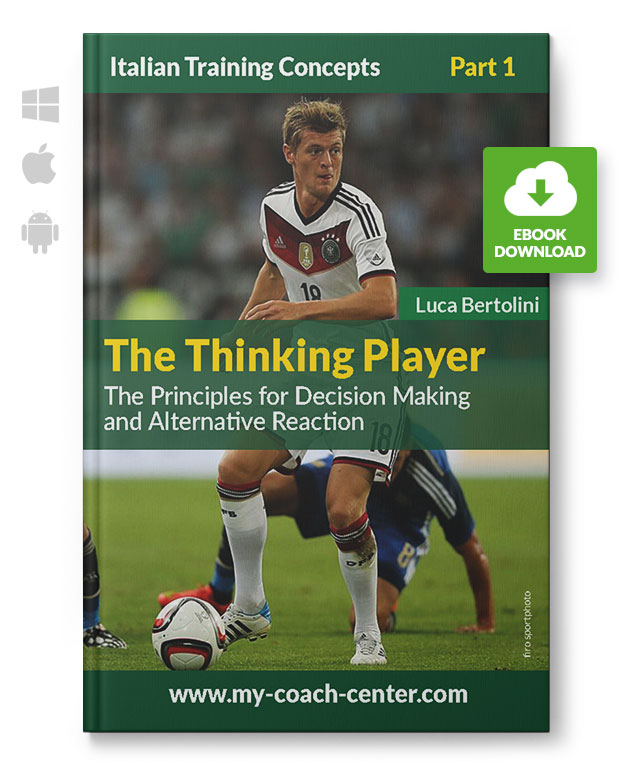Italian Training Concepts
Italian Training Concepts
%
PDF Preview of "• Individual practices for midfielders" Italian Training Concepts - Part 9 Individual practices for midfielders Author: Luca BertoliniPages: 71Graphics: 48Exercises: 46 There is an era of midfielders before Pep Guardiola and another era after his seasons at Barcelona; Busquets, Xavi, and Iniesta have changed the positions in the field and the meaning of the word, and the role. Following the word, midfielders are the players who stand and act in the middle third of the field; from this point of view, Steven Gerrard and Frank Lampard have already changed the role, creating the box-to-box midfielders. On the other side, Guardiola's Tiki-taka is over at this stage of tactical developments. However, the consequences of this period are still affecting soccer, as he created the attacking midfielders, "using" Busquets as holding and defensive midfielder in front of the defensive line. In his proper definition, a holding midfielder is probably the purest form of a defensive midfielder, as he holds his position close to the team's defense. There are 3 types of midfielders that protect the back defensive line, launch the building-up phase, and support the consolidation and possession phases of play. The proper defensive midfielder, the holding or deep-lying midfielder, and the deep-lying playmaker. Other types of categorized midfielders are the hybrid midfielder, who doesn't help the defense as a first task, but he acts as the game's flow requires, or the box-to-box midfielder, who plays with excellent Positioning, defensively and offensively. Are the wingers midfielders? Or do these players act in a completely different role? Are the inverted fullbacks midfielders? The wingers become "Mezzale" in the building up and defensive phases of the 1-4-4-2. If the mezzale are destructive players, they become Mediano(s). Jürgen Klopp and Pep Guardiola have created the final review of the midfielder's role definition in Germany and England; the inverted fullbacks allowed the midfielders to act as attackers and push up fullbacks have required the wide midfielders to patrol the half-spaces and the flanks at the back. The No.10s are now midfielders, attacking and pressing midfielders. Even though they are not frequently immediately involved in the building up phases, they are now points of reference in the possession, consolidation, and finishing stages of the moves. Eventually, technical skills, flexibility, awareness, and peripheral vision are the main requirements for a midfielder who must: Support the building-up phase Allow a center back to stand wider Move the ball at the back Allow a center back to stand wider Cut off the pressure lines Allow a center back to stand wider. Use the goalkeeper as a back apex to create a 3 v 2 duel Manage the ball in the middle third (possession and consolidation phases) Back apex, behind the attacking lanes, and in front of the defensive line. Support the finishing stages of the moves. These are the situations of play which the book aims to coach.
€13.95* €14.95* (6.69% saved)
%
Italian Training Concepts - Part 2 Create Finishing Chances and Score - 24 Positional and Small Sided Games Author: Luca Bertolini Edited by: Peter Schreiner Editor: Institute of Youth Soccer, Essen – Germany Pages: 48 Graphics: 38 Description: In this second e-book by Luca Bertolini the main theme is the organization of positional games involving eleven players (goalkeeper included) with the three classic roles of these games: players with possession, without possession and free players as support to the team with possession. One of the main goals is to create always numerical superiority for the players in possession to allow them to have the chance to finish and score. The most important difference with all the other positional possession games is that all the free players are placed in crucial roles in the games as they would have in the most important systems of play we see on the pitch in modern soccer: 1-4-3-3, 1-4-2-3-1, 1-3-5-2, 1-4-4-2. Another interesting focus of this e-book are the never-ending transitions phases of the exercises; the goal to score is always the same and for this reason when the defenders recover the ball they must replace themselves on the pitch looking for the help of the free players and they look for it again when they have to organize a new attacking move. It would be very interesting to find a physical training point of view on the games; as they are small sided games, with the coach who always kicks new balls inside the pitch, they can be useful also for athletic workouts for the players, changing the role every established limit of time. The sequence of the exercises depends on the level of complexity as the games are always organized with a goalkeeper and 4 vs 4 duels with two free players or 3 vs 3 duels with four free players; all these games are easier for the attacking team as one of the main goal is to create finishing chances and score.
€13.95* €14.95* (6.69% saved)
%
PDF Preview of "Individual and Small Group Training for Strikers - 2" Italian Training Concepts - Part 10 Individual and Small Group Training for Strikers - 2 Author: Luca BertoliniPages: 75Graphics: 54Exercises: 34 This book has the goal to coach the strikers from an individual point of view, involving them in 2 v 2, 3 v 2, and 3 v 3 (+ goalkeeper) situations to improve their individual cooperation and technical skills and to let them learn how to play focusing on tactical principles of play: 2 striker v 2 defenders + goalkeeper: striker with the ball at his feet and striker without the ball at the beginning. 3 strikers v 2 defenders + goalkeeper: 1 striker with the ball at his feet and 2 strikers without the ball at the beginning. 3 strikers v 2 defenders + goalkeeper: 3 strikers without the ball at the beginning. 3 strikers v 3 defenders + goalkeeper: 1 striker with the ball at his feet and 2 strikers without the ball at the beginning. 3 strikers v 3 defenders + goalkeeper: 3 strikers without the ball at the beginning. To cooperate and be linked with teammates and to act against more than one defender (numerical advantage or equality situations) are only tools to coach the players as unique actors; there aren't any connections with systems of play but with principles of play. The area of the field where the practices are set up is the final third, considering the division of the field into attacking sub-areas that the positional play philosophy inspires. The final third is divided into three 6 areas (2 along the flanks and 2 in the center). Small-sided games are widely used during soccer practices, and they enable players to experience situations they encounter during matches. On the other hand, small-sided games aren't enough to coach the strikers (and the defenders) despite leading them to develop their technical and tactical skills. Apart from technical skills coaching and individual tactical objectives of the small-sided games, the coach must plan specific tactical exercises to complete the learning and training processes. At this point, we come back to talk about individual training; all the specific tactical skills require individual training first of all. These skills have to be connected to the teammates and related to the opponents to create cooperation (after individual training, both whiles attacking and defending) and connections to beat the opponents. This is what this book aims to coach.
€13.95* €14.95* (6.69% saved)
%
Italian Training Concepts - Part 4 Individual and Small Group Tactics Author: Luca Bertolini Pages: 68 Graphics: 53 Exercises: 44 This first volume is about the basic individual and small groups principles to play in between the lines. Cut a line of two opponents dropping back paying attention to the timing of relation between passer and receiver. Cut a line of two opponents running forward and receiving in behind paying attention to the timing of relation between passer and receiver. Cut two lines of three opponents (defending triangles) dropping back among them and how to manage the possession being outnumbered and under pressure. Cut two lines of three opponents (defending triangles) running forward and receiving in behind and how to manage the possession being outnumbered and under pressure. The players must be coached on individual tactics when in possession first, before talking about tactical developments from a team or playing situation point of view, which will be the main theme of the second volume.
€13.95* €14.95* (6.69% saved)
%
Author: Luca Bertolini Pages: 72 Illustrations and Figures: 102 If we think about all the systems of play, there are many types of defense tactics; the first big difference can be found among the defense lines with three, four or five players. But these following can be considered deeper differences: How to play during negative transitions How and when to put pressure How and when run back to cover the spaces How and when to try to recover the ball How and when play with counterpressing How and when mark an opponent and when to cover the back spaces to him Who is the first defender among the forwards in the final or in the middle third Who is the defending midfielder or when to follow the opponents or when to try to close him. Or, why not, who is the defender who manage the whole defensive line. But there are common principles of play of defense which every player should know as basic skills. These are the individual tactics principles of defense against one an opponent. These skills should be learned by all players as they are so independent from the systems of play. In this book there is a progression of exercises which starts from some simple sequences, which will lead up to a final exercise where all the principles of play are mixed during its development. All exercises are combined with little goals to save and use as reference point. The final exercises include a regular goal and a goalkeeper who takes active part in it; this is useful to train the players to defend looking always at the opponent, the ball and the goal with his teammate goalkeeper.
€13.95* €14.95* (6.69% saved)
%
PDF Preview of "Coaching the Inverted Fullbacks" Italian Training Concepts - Part 8 Coaching the Inverted Fullbacks Author: Luca BertoliniPages: 81Graphics: 51Exercises: 38 The definition of the "Inverted Fullbacks" may create a misunderstanding: they are not a right-footed player on the left or left-footed players on the right as for the wingers, but they are fullbacks who join the center space of the midfield, running or carrying the ball in front of the center backs, creating more passing options in the center areas of the field, replacing the right and center midfielders, which can become offensive players close to the center forward and play in between the opposition defense lines. From a defensive point of view, inverted fullbacks ensure balance at the back, in case of loss of possession and allowed the now advanced midfielders to counter-press the opposition through numerical advantages around the ball, together with midfield wingers. The inverted fullbacks' significant and weak points are the low options for overlapping runs to support the finishing stage of the moves, the risk of leaving the wingers along, and overloading the center spaces too much, with no chance to stretch the opposition midfield line. These issues can be fixed anyway by high-speed skilled wingers who can run up and down the flanks, from the middle line to the end line, and by high rhythm possession in the middle to travel the ball to the center final third or out wide. Pep Guardiola is the inventor of this team tactical shape; as already stated, the positional play idea of Guardiola probably took him to use these tactics at Bayern Munich, looking for numerical advantage around the ball all over the attacking half of the field, the chance to exploit the skills of his wingers and for the immediate recovery of the ball after its loss. Inverted fullbacks are linked to Pep's creative invention, the "Half Spaces." As these kinds of fullbacks overload the center and the wingers are asked to be placed as wide and possible, Guardiola has been able to open two channels between the flanks and the center, where the center backs, while building up, and the offensive midfielders, when the team is finishing, often act. Obviously, the "Half Spaces" are the territory of exchanges of positions, many kinds of possible patterns of play between the attacking players; mobility is essential inside these spaces. Inverted fullbacks inside the half-spaces and wingers along the flanks, never placed on the same vertical line, where defenders can easily cover passes, if not time, made this field possible; these spaces call us to mind the positional play. This is the reason for this book; try to coach the inverted fullbacks through the positional game to understand the patterns of play and then with small-sided games to take them into the situations with attacking and defending transitions.
€13.95* €14.95* (6.69% saved)
%
PDF Preview of "Playing Between the Line - Part 2" Italian Training Concepts - Part 5Small groups and team tactics Author: Luca BertoliniPages: 80Graphics: 48Exercises: 44 In the first volume that is made of the first four main points of this book set (1-4), two lines has been shaped by pressing defenders and covering defenders of a same line. These are the main objectives of exercises’ sections that are included in this second volume: Cut a defending line of 4 opponents by dropping back among them and receiving a pass behind them after a triangle combination. Cut two defending lines of 4 + 3 opponents by running between them and receiving a pass behind the last defense line after a triangle combination. Cut two defending lines of 4 + 3 opponents by dropping back, running between them and receiving a pass behind the last defense line after a triangle combination. Cut two defending lines of 4 + 3 opponents by dropping back, running between them and receiving a pass behind the last defense line (4) after a triangle combination. Table of Contents Cycle passing pattern (1) Cycle passing pattern (2) Cycle passing pattern under pressure (1) Cycle passing pattern under pressure (2) Alternate cycle passing patterns under pressure 2 + 2 v 4 with goalkeeper Alternate 2 + 2 v 4 with goalkeepers Cycle passing patterns under pressure (3) Cycle passing patterns under pressure to finish Passing and movements pattern of play to finish (1) 2 + 2 v 4 with goalkeeper (2) Alternate 2 + 2 v 4 with goalkeepers (2) Cycle passing pattern (3) Cycle passing pattern under pressure (3) Passing and movements pattern of play to finish (2) 4 v 3 and 2 v 4 with goalkeeper (1) 4 v 3 and 2 v 4 with goalkeeper (2) 4 v 3 and 2 v 4 with goalkeeper and counter-attacks Alternate 4+3 v 1 Alternate 4+3 v 1 with goalkeepers Alternate 4 v 3 with goalkeepers (1) Alternate 4 v 3 with goalkeepers (2) Cycle passing pattern (4) Cycle passing pattern battle (1) Cycle passing pattern under pressure (4) Cycle passing pattern under pressure and counter-attacks Cycle passing pattern under pressure with goalkeeper and counter-attacks 3 v 3 + 4 v 1 (1 v 2) 4 v 1 and 1 v 4 (+3) with goalkeepers 4 v 1 and 1 v 4 + 3 v 3 with goalkeepers (1) 4 v 1 and 1 v 4 + 3 v 3 with goalkeepers (2) Double 4 v 4 and goalkeepers (1) Double 4 v 4 and goalkeepers (2) Cycle passing pattern (5) Cycle passing pattern battle (2) Alternate cycle passing pattern battle to finish with goalkeeper Cycle passing pattern (6) Alternate cycle passing pattern battle to finish with goalkeepers Passing and movements pattern of play to finish (3) 3 v 3 and 3 v 4 with goalkeeper Alternate 3 v 0 and 3 v 4 with goalkeepers Alternate 3 v 0 and 3 v 4 with goalkeepers and counter attacks 3 v 3 and double 3 v 4 with goalkeepers (1) 3 v 3 and double 3 v 4 with goalkeepers (2)
€13.95* €14.95* (6.69% saved)
%
PDF Preview of "Individual and small Group Training for Strikers" Italian Training Concepts - Part 7 Individual and Small Group Training for Strikers Author: Luca BertoliniPages: 74Graphics: 36Exercises: 33 This book has the goal to coach the strikers from an individual point of view, involving him in 1 v 1 + goalkeeper situations to improve their skills and to let them learn the basic tactical principles of play and to coach them in cooperating with teammates and against more than one defender (numerical advantage and disadvantage situations). This is the summary of the situations of play that the practices aim to coach: 1 striker v 1 defender + goalkeeper: striker with the ball at his feet and striker without the ball at the beginning. 2 strikers v 1 defender + goalkeeper: 1 striker with the ball at his feet and both strikers without the ball at the beginning. The area of the field where the practices are set-up is the final third, taking into consideration the division of the field into attacking sub-areas that it is inspired by the positional play philosophy. The final third is divided into three 6 areas (2 along the flanks and 2 in the center); a team is four times more likely to score a goal playing the ball from zone 14 towards the penalty area than the wings. The recovery of the ball in zone 14 leads to a goal almost 80% of the time. The exercises of the books are set–up and organized as follow: The spaces are set-up with grids that correspond to the attacking areas throughout the field’s final third (18 x 25 metres) each. There is always a regular goal with the goalkeeper to finish, wherever the practice starts. The striker must always beat an opponent (passive at the beginning and then fully active) before shooting. When the defender wins the possession dribbles the ball toward the zone 14 and the striker has 6” to recover the possession and then he can try to score again (to coach the principles of play of recovering the ball in that field’s area). The striker may face also a time pressure, when he must score within a fix limit of time. The strikers (from 2 v 1 to 3 v 3 practices) may start the sequence inside the same grid or inside different grids or they could be required to overload a specific area to create numerical advantage before shooting on goal. When defenders are more than one and they can win the ball, they always have to pass it inside zone 14, as in the 1 v 1 practices, and the strikers have 6” to recover the possession to try to shoot on goal again. Even in the small group practices, the strikers may face also a time pressure, when they must score within a fix limit of time. All the small group practices include the developments of the team’s possession principles of play while attacking (overlaps, underlaps, blind side run, direct and indirect attacks, cut, triangle passing combinations and 1 v 1 duels before passing).
€13.95* €14.95* (6.69% saved)
%
PDF Preview of "Coaching Movement off the Ball" Italian Training Concepts - Part 6Coaching Movement off the Ball and Rotation in a Three-Player Midfield Area Author: Luca BertoliniPages: 100Graphics: 51Exercises: 40 All or many tactical trends come from the most important one: the positional play (or Juego De Posicion); it is preparative to support the man in possession and to create a passing lanes behind the nearest pressure line, to progress the move toward the final third. In the end, we are talking about the players’ rotations. Whatever are the systems of play, these are the crucial skills: To shape positional triangles while building up. To create support angles while rotating. To support the possession and consolidation phases, to dribble the ball up the field, or to find the right passing lanes. To re-form the triangles, when the opposition can mark them or cover the spaces they tried to create Peripheral vision is vital Their way to arch the runs to have the best overview of the field They must be ready to play with 1 or 2 touches wherever they have to drive a pass (short or long distances, ground or aerial). The main aims of the positional play are: To dominate possession. To stretch the opposition's lines. To brake the pressure lines. To place players between the opposition lines and into specific areas. To create passing lanes and angles to pass forward to a teammate in the space, advancing the move, or to a teammate, who has time and space available, to receive and pass again to a third man. Coaching midfield rotations is vital for players and teams, to allow the building-up phase, the possession and consolidation phases, and to coach the players receiving and preparing the phase before the finishing one.
€13.95* €14.95* (6.69% saved)
%
eBook: The Thinking Player Italian Training Concepts - Part 1 Author: Luca Bertolini Edited by: Peter Schreiner Editor: Institute of Youth Soccer, Essen – Germany Pages: 46 Graphics: 68 Description: The training systems for the individual tactic of a youth player can be divided into two kinds. Every player can be trained for the specific role he will have inside a team during a match or he can be trained to be ready to be an attacker, a defensive or attacking midfielder or an outside forwarder depending on the specific situation he is in during a match. The training sessions for the first type of player must be repetitive and the exercises could be boring for him, since he must be constantly trained for one single role. The habits of this kind of player on the field could be fixed without any chance to be developed in his future. On the other side, a “thinking player” is crucial and more useful for his team as he can play at his best and as the situation requires on the field; his role will be specified when and if he is a first team player. The principles of play of football are always general and all the players shall know them and be prepared to carry them out on the field. Therefore, I created these exercises where all the roles are unknown at the beginning and they are decided by one teammate, by the goalkeeper or by the situation of the exercises while they’re being carried out on the pitch; all of them are organized on small sized pitches and they can be set up very fast. Every single player can be an attacker, can become a defender after an attacking move and a lot of transitions are always present; they must think quickly and they must find the best solution to adapt themselves to the situation. Few exercises have coordinative goals included. The most outstanding point of view in this ebook is that all the exercises require to score in big or small goals at the end of any move. Luca Bertolini Contents: Introduction 4 01: Countermovements, cut runs and 1 vs 1 6 02: Coloured 1 vs 1 or 2 vs 1 8 03: 1 vs 1 and following 1 vs 2 9 04: 1 vs 1 in succession and following 1 vs 2 10 05: 1 vs 1 decided by the goalkeeper and under time pressure or 2 vs 1 12 06: Two kinds of 1 vs 2 14 07: 2 vs 1 called by the goalkeeper or 1 vs 2 15 08: 2 vs 1 or 1 vs 2 16 09: 1 vs 1 called by the goalkeeper or 2 vs 2 17 10: 2 vs 2 called by the goalkeeper 18 11: 2 vs 2 decided by the first receiver 19 12: 2 vs 2 decided by the goalkeeper and the first receiver (1) 21 13: 2 vs 2 decided by the goalkeeper and the first receiver (2) 22 14: Shoot in the main goal or 2 vs 2 in 3 goals 23 15: 1 vs 1 under time pressure or 2 vs 2 24 16: 1 vs 1 and following 2 vs 2 (1) 25 17: Double 1 vs 1 and following 2 vs 2 (2) 26 18: Double passing sequence, 1 vs 1 and 2 vs 2 28 19: Clock passing sequence exercise, 1 vs 2 and 2 vs 2 30 20: From 1 vs 1 to 3 vs 3 (1) 32 21: From 1 vs 1 to 3 vs 3 (2) 33 22: 4 vs 2 or 4 vs 3 (1) 34 23: 4 vs 2 or 4 vs 3 (2) 36 24: Temporary 4 vs 2, 4 vs 3 or 4 vs 4 38 25: 4 vs 4 + 3 decided by the goalkeeper 40 26: 6 vs 4 with goalkeeper to switch play 41 27: 3 vs 3 and/or 6 vs 3 decided by the goalkeeper 42 28: 1 vs 1 or 3 vs 3 or 6 vs 6 decided by the goalkeeper 44
€13.95* €14.95* (6.69% saved)

